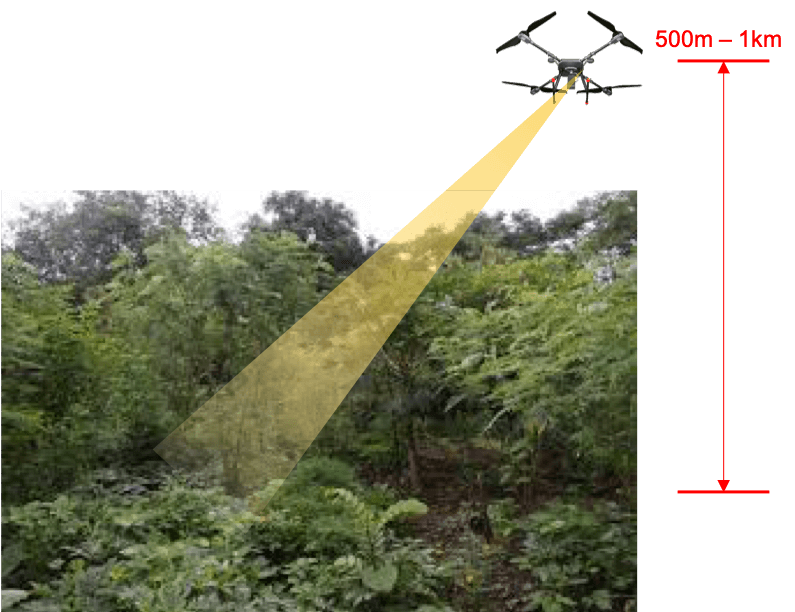
Small LIDAR (scanning laser) systems can be used for obstacle detection and SLAM from a moving drone. Whilst more work is still needed on the integration of the data from these sensors into the flight software, the theoretical performance can be evaluated based on the specifications of the laser and the mechanical movement.
Ideally, we would like to have an obstacle detection system that has no “gaps” in the data, gaps which might allow small objects to get dangerously close. We would also like each scan of the surrounding area to be updated instantaneously. Of course, these requirements may not be practical or cost effective but it is still useful to know how good a particular LIDAR might be in practical circumstances.
Lidar

For the purposes of this discussion, I will examine a simple single axis scanner, since these are the most commonly available type of small LIDAR, but the same analysis can be applied to multi-axis or multi-beam devices.
Looking first at the refresh rate of the entire data set, this is determined by the time that it takes the LIDAR to complete a full set of measurements as controlled by the speed of the motor. We can call this rate Frefresh [Hz].
Taking the laser measuring rate as Flaser [Hz] we can calculate the point separation, Psep [deg] of each measurement as follows:
Point separation: Psep = 360 * Frefresh / Flaser
The closer the point separation, the smaller the gap will be in the data that allows obstacles to go undetected. There is always some divergence on the laser beam, so if the point separation is less than or equal to this laser beam divergence then the data can be regarded as “saturated” in the sense that there is 100% coverage and no obstacles will be missed. This means that our first requirement for no “gaps” in the data is surprisingly possible for some combinations of refresh rate and laser measuring rate.
Let’s take a closer look at the refresh rate. Suppose that we consider drones traveling at a speed of Vdrone [m/s] where the time taken to stop or take avoiding action is Tstop [s]. The stopping distance, Dstop [m] can be calculated as:
Stopping distance: Dstop = Vdrone * Tstop
Even if our LIDAR has zero refresh time, it has to be able to measure at least this stopping distance to prevent the drone from crashing. For a longer refresh time it needs to be able to measure further in order to give sufficient time for the drone to stop and sufficient time for a complete refresh of the data. The measuring range, Drange [m] of the LIDAR needs to be:
Measuring range: Drange = Vdrone * (1 / Frefresh + Tstop)
————————————————————–
Let’s look at an example:
A drone is traveling at 30kph and can stop in 2 seconds. Can a LIDAR with a range of 25m, a beam divergence of 0.2 degrees and taking 500 readings per second protect this drone from hitting a telephone pole?
We can regard a telephone pole as a small target so to get 100% coverage we would need:
Maximum refresh rate: Frefresh = 0.2 / 360 * 500 = 0.28 [Hz]
At this refresh rate the required range would be: Drange = 8.3 * (1 / 0.28 + 2) = 46.2 m
This range is further than the LIDAR can measure so the drone might well hit the pole, even if the LIDAR does see it.
————————————————————–
I think the most surprising thing about this result is that a LIDAR needs to have BOTH a very fast update rate and long measuring range before it can effectively protect a drone from hitting “small” objects like poles, wires, tree branches and all the things that drones seem inexplicably attracted to. It is for these reasons that we have been working on long range, high speed laser modules that can be built into LIDAR systems. The SF40 LIDAR pictured above (SF40 web page) uses an SF30/C laser module (SF30/C web page), so how good will its performance be in practice?
————————————————————–
As a second example, the SF40 LIDAR is configured to measure at 10kHz and rotates 5 times per second. The laser module can detect thin wires at 25m, poles at 50m and walls and trees at 100m. If a drone can stop in 2 seconds, how fast can it fly and still safely avoid an unexpected tree?
————————————————————–
Point separation: Psep = 360 * 5 / 10000 = 0.18 degrees
This means that there is 100% saturation and no gaps in the data, so even small obstacles will be detected.
The maximum safe speed of the drone: Vdrone = 100 / (1 / 5 + 2) = 45 m/s (164 kph)
How fast could this drone fly without hitting a power line?
The maximum safe speed of the drone: Vdrone = 25 / (1 / 5 + 2) = 11.4 m/s (41 kph)
————————————————————–
This result suggests that the SF40 LIDAR will work well for both high speed operation, where large obstacles might be encountered, or slower speed operation closer to small obstacles.










